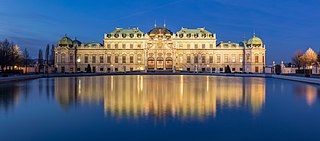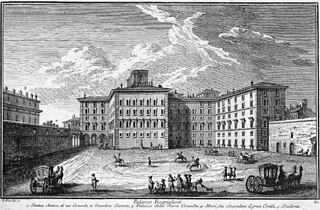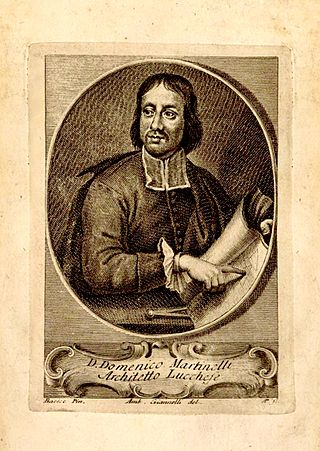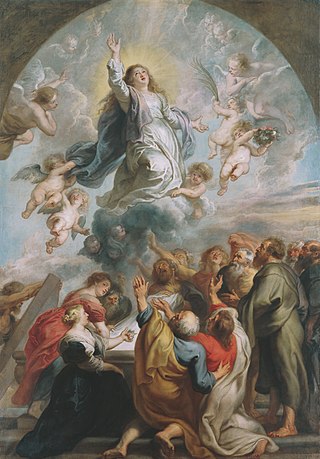
The Belvedere is a historic building complex in Vienna, Austria, consisting of two Baroque palaces, the Orangery, and the Palace Stables. The buildings are set in a Baroque park landscape in the third district of the city, on the south-eastern edge of its centre. It currently houses the Belvedere museum known in German as the Österreichische Galerie Belvedere. The grounds are set on a gentle gradient and include decorative tiered fountains and cascades, Baroque sculptures, and majestic wrought iron gates. The Baroque palace complex was built as a summer residence for Prince Eugene of Savoy.

Johann II, nicknamed the Good, was Prince of Liechtenstein from 12 November 1858 until his death in 1929.

Simon Vouet was a French painter who studied and rose to prominence in Italy before being summoned by Louis XIII to serve as Premier peintre du Roi in France. He and his studio of artists created religious and mythological paintings, portraits, frescoes, tapestries, and massive decorative schemes for the king and for wealthy patrons, including Richelieu. During this time, "Vouet was indisputably the leading artist in Paris," and was immensely influential in introducing the Italian Baroque style of painting to France. He was also, according to Pierre Rosenberg, "without doubt one of the outstanding seventeenth-century draughtsmen, equal to Annibale Carracci and Lanfranco."

The Palazzo Pitti, in English sometimes called the Pitti Palace, is a vast, mainly Renaissance, palace in Florence, Italy. It is situated on the south side of the River Arno, a short distance from the Ponte Vecchio. The core of the present palazzo dates from 1458 and was originally the town residence of Luca Pitti, an ambitious Florentine banker.

Palais Rothschild refers to a number of palaces in Vienna, Austria, which were owned by members of the Austrian branch of the Rothschild banking family. Apart from their sheer size and elegance, they were famous for the huge collections of valuable paintings, statues, furniture, books and armour that they housed, another reflection of the family's vast wealth and prominent position.

The Petit Palais is an art museum in the 8th arrondissement of Paris, France.

The House of Liechtenstein, from which the principality takes its name, is the family which reigns by hereditary right over the principality of Liechtenstein. Only dynastic members of the family are eligible to inherit the throne. The dynasty's membership, rights and responsibilities are defined by a law of the family, which is enforced by the reigning prince and may be altered by vote among the family's dynasts, but which may not be altered by the Government or Parliament of Liechtenstein.

Prince Constantin of Liechtenstein, known professionally as Constantin Liechtenstein, was a member of the Princely House of Liechtenstein, and a businessman. He was the third son of Prince Hans-Adam II and his wife, Countess Marie Kinsky of Wchinitz and Tettau. He was the chief executive officer of the LGT Group from 2020 to 2023.

The Massacre of the Innocents is the subject of two paintings by Peter Paul Rubens depicting the episode of the biblical Massacre of the Innocents of Bethlehem, as related in the Gospel of Matthew (2:13–18). The first, measuring 142 x 182 cm, was painted after his return to his native Antwerp in 1608, following eight years spent in Italy.

The Palazzo Pallavicini-Rospigliosi is a palace in Rome, Italy. It was built by the Borghese family on the Quirinal Hill; its footprint occupies the site where the ruins of the baths of Constantine stood, whose remains still are part of the basement of the main building, the Casino dell'Aurora. Its first inhabitant was the famed art collector Cardinal Scipione Borghese, the nephew of Pope Paul V, who wanted to be housed near the large papal Palazzo Quirinale. The palace and garden of the Pallavicini-Rospigliosi were the product of the accumulated sites and were designed by Giovanni Vasanzio and Carlo Maderno in 1611–16. Scipione owned this site for less than a decade, 1610–16, and commissioned the construction and decoration of the casino and pergolata, facing the garden of Montecavallo. The Roman palace of this name should not be mistaken for the panoramic Villa Pallavicino on the shores of Lake Como in Lombardy. The Palace has also been the scene of important cultural and religious events. On June 6, 1977 Princess Elvina Pallavicini invited in Palazzo Pallavicini Rospigliosi the archbishop monsignor Marcel Lefebvre for a conference on the Second Vatican Council and for the celebration of a Traditiona Mass, under the careful direction of the marquis Roberto Malvezzi, and Frigate Captain marquis Luigi Coda Nunziante di San Ferdinando. Many members of Alleanza Cattolica, the baron Roberto de Mattei, the pharmacologist Giulio Soldani, the sociologist Massimo Introvigne, the psychiatrist Mario Di Fiorino and Attilio Tamburrini and his brother Renato Tamburrini took part to the event.
Palais Liechtenstein may refer to:

Stadtpalais Liechtenstein is a residential building at Bankgasse 9, in the first district of Vienna, Innere Stadt. The palace was built from 1692 to 1705 by the Italian architect Domenico Martinelli and the Swiss architect Gabriele Gabrieli.

Domenico Martinelli was an Italian architect who worked for Carlo Fontana during 1678. He was an evident figure in the shaping of Baroque style in the North Alps. In 2010, a musical tribute called "Project Martinelli" was performed to him in Munich.

The Lobkowicz Palace is a part of the Prague Castle complex in Prague, Czech Republic. It is the only privately owned building in the Prague Castle complex and houses the Lobkowicz Collections and Museum.

Hans-Adam I was the son of Karl Eusebius, Prince of Liechtenstein (1611–1684) and Princess Johanna Beatrix of Dietrichstein (1625–1676).

Domenico Egidio Rossi was an Italian architect and master builder, most notable for his design of the Schloss Rastatt.

Wilfersdorf Castle is located in the Weinviertel in the town of Wilfersdorf, in the Mistelbach district. The castle and its estate have been continuously owned by the Liechtenstein family since 1436. It always served as a summer and hunting seat of the reigning princes. Today it also houses a cultural and exhibition centre as well as the property management offices of the princely estates in Weinviertel. It is renowned for its princely cellars. A well-known white wine is produced here on 38.5 hectares of vineyards.

Assumption of the Virgin Mary is a c.1637 oil on canvas painting by Peter Paul Rubens. It was commissioned for the high altar of the Carthusian Church in Brussels by Charles and Johannes Angelus de Schotte between 1629 and 1639. Two oil sketches for it are now in the Courtauld Institute and Yale University Art Gallery.
Princess Maria-Anunciata of Liechtenstein is an art curator and member of the Princely Family of Liechtenstein. She is the granddaughter of Franz Joseph II, Prince of Liechtenstein and of Jean, Grand Duke of Luxembourg.

The Liechtenstein Palace is a neoclassical palace near Maria Enzersdorf in Lower Austria, bordering Vienna. It is on the edge of the Vienna Woods. It stands opposite south of Liechtenstein Castle, the ancestral seat of and place of origin of the House of Liechtenstein, the ruling family of the Principality of Liechtenstein. Prince Johann I of Liechtenstein (1760–1836) built the neoclassical palace in Biedermeier style at the start of the 19th century as one of the princely summer residences. In the aftermath of World War II, the palace fall into ruins and has been sold by the princely family.













































